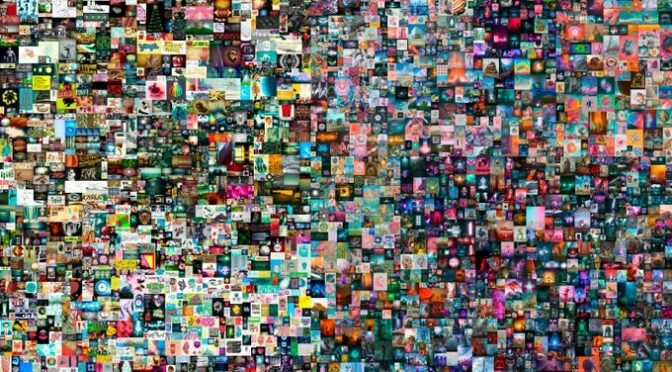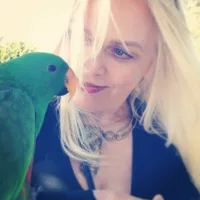It doesn’t matter what the art is. It doesn’t matter who the artist is. The only thing that matters is a digital file that has a verified identity and ownership. It’s called a “non-fungible token” or, more commonly, an NFT.
Using blockchain technology, a system that marries mathematics and cryptography (aka crypto) to make something unhackable, NFTs use a digital ledger to secure the value of an asset, like a piece of art, that has been tokenized. (Tokenization is a process where an asset is converted into a token that can be moved, stored, or recorded on a blockchain).
The digital artwork is uploaded to an auction market. Its ownership is stored as a decentralized, open-source block-chain that anyone can check. As NFTs are not mutually interchangeable, enthusiasts’ would like to convince us that NFTs or crypto art is as collectible as the fine art that grace our walls.
With the sale of the Beeple NFT that sold at Christie’s for 69.3 million in May, we may infer this may be the new direction of art. It’s important to know that the piece was comprised of one digital painting a day created over 14 years by Mike Winkelmann, aka Beeple.
That theory goes out the window when a lot of 9 CryptoPunks pixelated portraits sold for 17 million as NFTs at the same auction house. The message was clear. It’s not about the art, it’s about owning an asset, albeit a unique file, that can live on blockchain sold or traded by a verifiable owner. It cannot be duplicated or tampered with. All that matters is having the ability to securely value, purchase, and exchange a digital image using a digital ledger. Non Fungible Tokens are not about loving the arts or supporting artists; they are about moving around money.
In full disclosure, I have always seen digital art as an advertising or film tool, not fine art. I am not a tech geek but I am married to one. (Ironically, an expert in Blockchain). My apprehension about using computers as an art medium comes from multiple experiences with digital obsolescence. The software needed to access a digital file becomes obsolete.
People, especially those raised on tech, think everything created on a computer exists forever in the “cloud”. In reality, everything created using virtual technology is ephemeral. An oil painting can survive over 400 years; fresco’s for even longer. Try getting images off USB PCI cards, floppy discs, or zip drives if you are not an expert.
We live in a corporate climate that continuously devalues the arts while profiting off the work of trained artists. Computer games topped $159B in 2020 and artists continue to be paid a fraction of coders. As long as we live in a culture that devalues the arts, artists will continue to be exploited for financial gain.
I’ve written many articles on why right-leaning governments remove the arts from schools. It’s important to understand that digital manipulation does not train the eye in the same way artists learn to draw with paper and pencil.” Traditional fine art develops the part of our brain that not only creates but helps us creatively solve problems. It’s the same part of our brain that helps us see through manipulation. This is why historically one of the first actions taken by fascist governments has been to shut down the fine arts. Is there a correlation between what is happening politically right now and NFT’s? Perhaps.
Are NFTs the future of the art market? I seriously doubt it. Art collectors are in it usually for the love of what they collect. They are often as educated on their subject as the best curators. Collectors often know more about the art they collect than they do their own children. Owning a digital file token just doesn’t seem to fit the profile of most of the collectors I’ve met in my 38 years as an artist.
NFTs fit the profile more in line with the financial scandals over the last few decades. We all remember the exaggerated assets, false accounting, pump and dump stock schemes, inflated revenues, and the insider trading of the last few years.
Auction Houses and Brokerage Firms will sell anything that can make a profit. Let’s not pretend it’s about the art. The people who are buying NFTs appear to be the same people that have a vested interest in creating a market from the technology involved.
A resident of the San Francisco Bay Area, Uri has lived on three continents and visited 44 countries.


